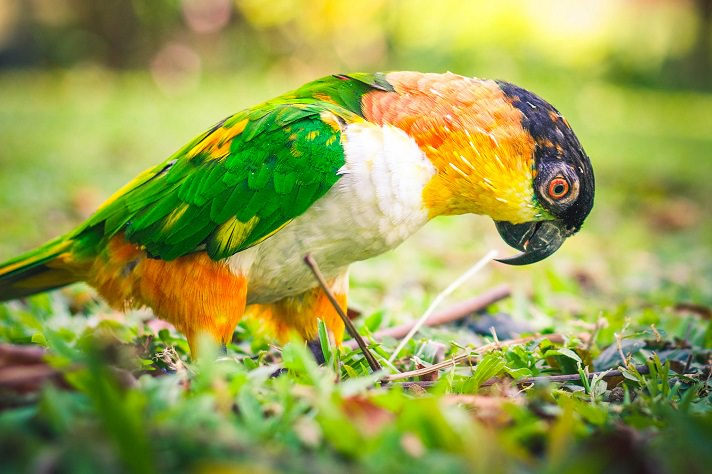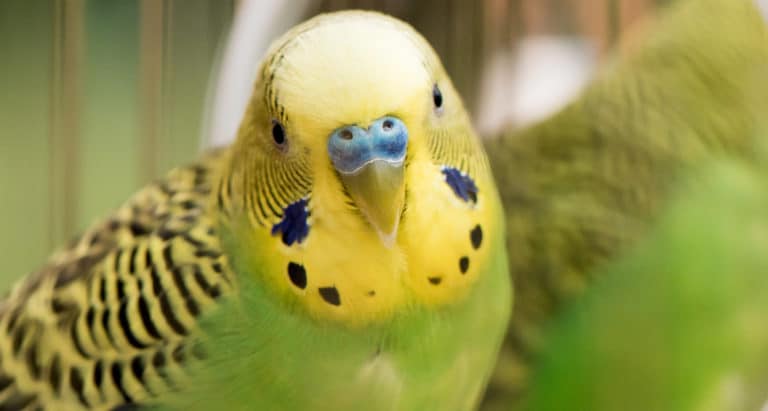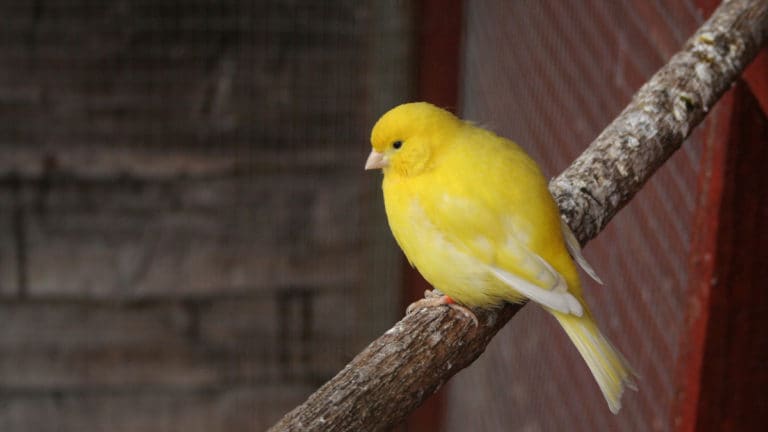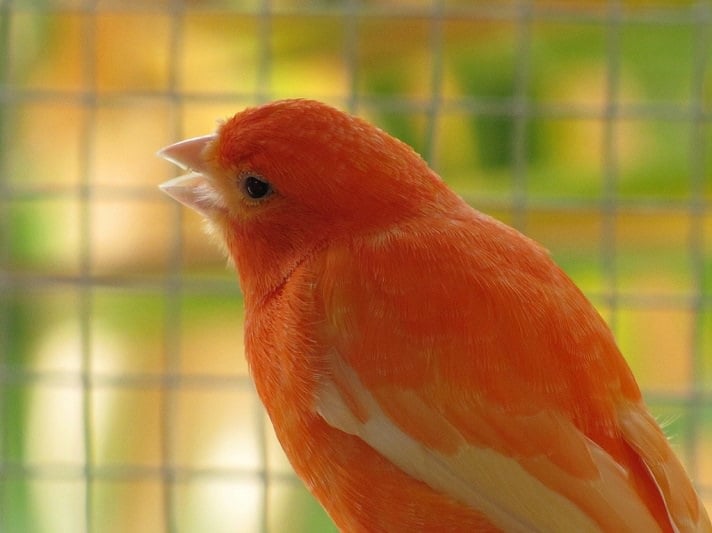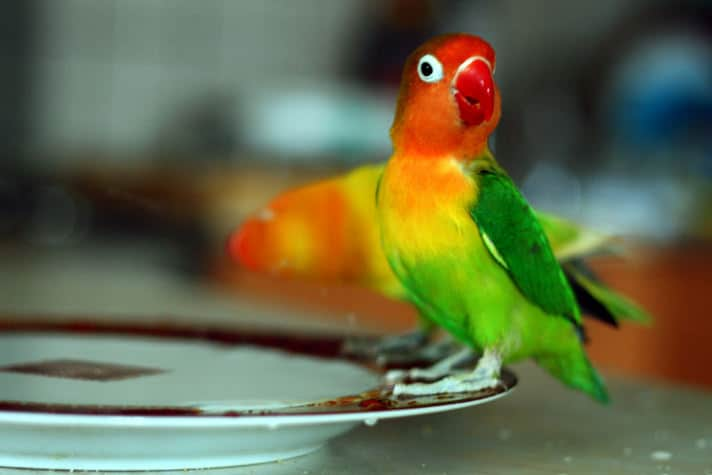You saw it at a pet store or bird show and were captivated by the non-stop antics of the colorful, 9-inch, hopping bird — a birdie gymnast with charisma to spare, and the only parrot with a white belly. The caique (pronounced ky-EEK) has you captivated. Now you wonder: What would it be like to own such a bundle of energy?
Types Of Caiques
There are two species of caique: the white-bellied caique (Pionites leucogaster) and the black-headed caique (P. melanocephala). The white belly includes three subspecies and the black head includes two. All caiques have a white belly, but only the black-headed caique has a black section of feathers on top of its head. Black-headed caiques are more common in the United States than the white-bellied caique.
In the most common white-bellied caique in the U.S. is sometimes called the yellow thigh (P. l. xanthomeria) because of its yellow thighs. The other subspecies are the green thigh (P. l. leucogaster) and yellow tailed (P. l. xanthurus), which also has yellow thighs, but a paler coloration overall.
The most common black-headed caique in the U.S., which is called the black-headed caique, is P. m. melanocephala. The second subspecies, Pallid (P. m. pallida), has orange feathering where there are yellow feathers in the other subspecies.
There is a small size difference between the two caique species. The white-bellied caique is usually 1/4 inch longer than the 9-inch black-headed caique, according to caique breeder Gloria Balaban of Florida. The white bellied is also more uncommon and therefore, more expensive than the black-headed caique. These seem to be the only notable differences between the species.
Pet Caiques: Delightful To Look At, But Better To Hold
“Caiques are definitely not the type of bird you buy just to look at,” said Tracy Day of Maryland, a three-year owner to Pooka, a black-headed caique.
Caiques live anywhere from 27 to 40 years or more, so you’ll be sharing your life with them for quite some time. Be prepared to spend many hours a week interacting with your pet caique.
“Caiques are a high-maintenance bird. They need a tremendous amount of human interaction to stay tame,” said Sally Blanchard, avian behaviorist and owner of Spikey LeBec, the owner of black-headed caique known as “the celebrity caique.”
If you work all day, lots of toys will help occupy your pet bird a little, but nothing takes the place of focused attention to keep your caique tame and happy.
“Caiques are very independent and playful birds that will usually entertain themselves. However, if given a choice between playing by themselves or being with their favorite human, they will pick the human,” said Day.
For a bird kept alone, this interaction is doubly important — and only common sense. The more intelligent the bird, the more interaction it requires, and caiques are very intelligent, according to Balaban. However, you don’t want your caique to rely on you too much.
Blanchard cautioned, “Caiques need to be dependent to a degree, but not so much that they become a nag.”
Also, a caique’s need for interaction depends on how it was socialized as a baby.
“Those that weren’t well socialized will have behavioral problems that might ruin their pet potential,” says caique breeder Veta Hollaway of South Carolina.
Are Caiques Right For First-Time Bird Owners?
Caiques are not a parrot for someone with little or no bird experience.
“You must always gently guide their behavior. If people don’t set rules and provide nurturing guidance, they can get into serious problems with caiques right away,” said Blanchard.
Balaban believes early socialization is important to a caique future behavior. She does not sell unweaned babies because they need to learn how to be birds and interact with each other before they can interact with humans.
Purchasing A Caique
Buy only from a reputable breeder or store that socializes and cares about its birds. Blanchard and Balaban suggested that you ask the following questions before making your choice:
- How was the bird socialized? (Watch for signs that it’s friendly or fearful.)
- Is it weaned? (Don’t purchase an unweaned bird.)
- What diet was it weaned onto? (The more variety, the better.)
- Has it been vaccinated for polyomavirus?
- If the bird is from a pet store, where did the store get it from? (A reputable breeder?)
- Does the bird know the “step-up” command? (This will prove it’s been socialized.)
Blanchard warns of another reason to be wary of caiques as a first-time bird: Aggression is met with aggression, so be gentle. Praise good behavior and ignore bad. Caiques do not forget or forgive, and you must constantly earn their trust.
“The more educated an owner is about how to handle a bird, the better the bird. Guide their behavior, do not punish,” says Blanchard.
If you can meet the needs of this high-maintenance bird, the payoff will be worth it.
“A person with a caique will certainly never be bored,” says Day.
The Ideal Environment For Caiques
Give your caique lots of cage space. Everyone agrees that bigger is better.
“I think birds need cages sized according to energy level,” says Blanchard. “Caiques need a lot of space.”
Spikey LeBec hangs out in a 36- by 24- by 48-inch cage with 3/4-inch bar spacing. Height is equally important as width for these birds, because they enjoy swinging on toys and playing Tarzan.
Toys are another reason you need a big cage.
“By the time you put all the toys caiques require in a cage,” says Hollaway, “there’s no room for a bird if the cage is too small.”
Dometop or playtop can be your own choice. Day recommends a dometop, “A playtop is nice, but a dometop gives you more usable room to hang toys for the bird to play.”
Caiques need plenty of time outside their bird cages. But their curiosity can get them into trouble, so they should always be supervised.
“Most caiques think of life as an amusement park ride. They’re into the adventure,” says Blanchard.
Spike once jumped onto the tail of her dog as it passed by. He also managed to climb on top of the microwave and pour powdered food on himself.
This same sense of adventure has a plus side, because it makes caiques good candidates for traveling, either by car or plane. Caiques are very adaptable when it comes to temperature or the need for quiet/noise.
“If you’re comfortable, they’re comfortable,” says Balaban.
However, when you first acquire your caique, Hollaway believes you should acclimate it if it’s coming from a situation that is much warmer or cooler than your own.
Caiques generally won’t mind a lot of commotion in a household. It all depends on what’s normal. However, you should provide a hide-away in their cage for those times that they wish to be alone.
“Caiques are either 100 percent on or 100 percent off. When they’re off, they want to retreat,” says Blanchard.
As for lighting, humidity and air purification, caiques have no special needs beyond those of other hookbills. The most important factor is probably lighting.
“All parrots need a lot of supervised time outdoors in a cage to bask in natural sunlight,” says Blanchard, “and a Vita Lite or other full-spectrum light for indoors.
Food, Glorious Food! (AKA Caiques Love Food)
Caiques love to eat. After a week or two, Balaban has had new clients contact her expressing amazement at the amount of food their new caique is eating. Reports of a finicky caique are very rare and are usually due to improper weaning. Owners must ensure that caiques get a balanced diet. Caiques enjoy variety, but their high energy demands a bit more fruit in their diet than most parrots usually get; vegetables high in vitamin A are another must. These, in addition to a seed and pelleted diet, should keep your caique healthy and happy. Because of the variety of food they enjoy, favorite treats vary.
“They’ll sell their soul for a grape,” says Balaban.
Blanchard allows Spike one nut a day.
Day’s caique, Pooka, enjoys strawberries and peppers (red, green and chili).
But be warned: “Caiques are very food possessive. The only time I expect Spike to bite me is when he’s eating a favorite food and I try to pick him up,” says Blanchard. This possessiveness might cause problems if you house two caiques together, in which case Blanchard recommends giving each caique its own food bowl.
Health Concerns For Caiques
Caiques are generally healthy birds. Although any bird can become ill, the only health problem caiques seem susceptible to is polyomavirus, a disease causing severe gastroenteritis that also targets the heart, liver and kidney. This is unique because polyomavirus is usually only a disease of birds under 4 weeks of age. Most often it is fatal.
“I vaccinate all my baby caiques and encourage clients to discuss an annual polyomavirus booster with their avian vet,” says Balaban.
Determining whether a booster is required may be based upon your bird’s risk of exposure. If a bird is kept singly and at home all the time, with no visitors from other bird families, risk is small.
Training And Talking For Caiques
Caiques are very intelligent and have natural behaviors that help them learn tricks quickly. Blanchard trained Spike to roll over and play dead when “shot” in only a half-hour, and to somersault in her hand within five minutes. Balaban believes most baby caiques can be taught to step-up in five to 10 minutes. Many caiques are potty trained. The only limitation seems to be the time and type of training the owner is willing to do.
Blanchard uses Spike’s natural hopping behavior to pretend he’s a wind-up toy. She winds him up, sets him on a table and he hops away. She also taught Spike to dance to music by playing off his natural bobbing behavior. She started whistling to his bobbing and gradually got him to bob to her whistling, too. To further prove their intelligence, Blanchard related a trick that Spike used to do at her seminars where he put rings on a stand. One day a ring rolled off the table and someone in the audience jumped up and put it back on the table. After just that one instance, Spike no longer put the rings on the stand. He dropped them and had someone in the audience pick them up. (For further adventures about Spikey LeBec, visit his Web site at: www.petbirdreport.com/spikey.shtml.)
Caiques are not at the talking level of an Amazon or African grey, but they do talk.
“Every pet caique I know says at least a couple of words. They talk in a little squeaky Minnie Mouse- or gruff Donald Duck-type voice,” reports Balaban.
Spikey LeBec says about 20 phrases and loves to whistle off key. Blanchard describes them as not being able to enunciate very well.
Balaban adds, “Strangers may not be able to understand what your bird says, but you will.”
Day and Hollaway stress that caiques love mimicking sounds, whistling songs, imitating the beep of a fax machine or microwave, a squeaky door or the meow of a cat.
To Pair Or Not To Pair Caiques
Balaban believes caique pairs are twice the fun: “Caiques are one of the few birds that you can maintain a human/pet relationship with even if paired.”
She warns that during breeding their desire to interact with humans drops dramatically. After breeding, they should be back to their lovable selves. This quality adds to the caiques’ uniqueness because most other birds are less tame and forget about their humans once they’re paired.
Hollaway believes that, if properly done, pairing caiques won’t hurt the human/bird relationship.
“This is the only bird that I will tell a prospective pet owner it’s okay to have two in the same cage, as long as the owner interacts with both caiques,” Hollaway says.
Having two caiques definitely increases an owner’s workload and time commitment. Both Blanchard and Day keep their caiques singly and have done very well (although Day is considering getting a second caique in the near future). Blanchard believes that if you pair caiques, it should be with the same sex, unless you have serious plans for breeding them.
Caique Personalities
“What I love so much about caiques is that they’re so full of themselves,” says Blanchard. “They snort through their nostrils when they try to show what hot stuff they are. They strut and snort.”
“Caiques are very outgoing and social,” says Day. “I think they view everyone and everything as a potential playmate. I think that caiques have two mottoes: ‘No fear!’ and ‘Life is short, play with as many toys as you can!'”
“Caiques are very smart and willful,” says Balaban. “They’re going to get their way. They’ll push and push, wheedle and connive. They’re determined birds.”
They also pick up on emotions around them, which sometimes causes interesting situations. While giving a seminar, Blanchard was rudely interrupted by the hotel maitre d’ and glared at him. Spike immediately jumped on the man’s nose! One of Balaban’s clients had to deal with her bird stalking her visiting mother like a cat. In one encounter, the mother was surprised to see the bird push open the slightly ajar door of her bedroom. Stunned by the bird’s strength and determination, the mother waited to see what would happen next. The bird finally flew onto the bed and tried to attack her.
Their determination also stretches across the years. Balaban’s 8-year-old white belly was in quarantine for the first 60 days when she first got him as a 2-year-old. She and her husband took him out and played with him on the bed at night. The caique discovered the curly wire on the telephone and wouldn’t leave it alone. They took the cord off and put it in a drawer so he wouldn’t ruin it. A couple of years later the caique was taken to the bedroom again for the first time since the quarantine — and he made a beeline for the phone cord. He remembered where it was from years before! Balaban advises that if your caique becomes obsessed with an object, take it out of view, like she did with the phone cord.
Another trait unique to caiques is their joy of surfing. “In the wild, caiques are an upper tree canopy bird. There are lots of flat leaf surfaces in the upper canopy, and caiques love to leaf bathe. Domestic birds satisfy this need by hair surfing. They spread the feathers on their cheek and thighs and rub their whole body on any nappy or textured surface. It’s not a sexual behavior,” says Blanchard. Despite this behavior, they’re not known to be big cuddlers. Day says that she equates them to cats, “They cuddle, but on their own terms.”
Caiques can be strong biters, but proper socialization should eliminate any problems. If biting does occur, it can be from fear. Analyze the situation surrounding a bite to prevent future problems. Caiques pick up on negative emotions. If there wasn’t a stimulus that may have scared your bird, were you scared or upset? Blanchard believes that a lot of caique aggression (lunge biting) comes from being excited. If a caique is wound up or excited, pet it slowly. Slow it down by slowing down your own energy.
Don’t confuse chewing with nipping. Chewing on owners is normal and shows affection. Caiques like being handled. Blanchard guesses that chewing on you is their way of reciprocating your handling. If a bird is actually nipping, Blanchard suggests that you give it something else to nip besides your finger. Balaban considers caiques a very “beaky” species. “They’ll use their beak to explore you, but don’t encourage rough play.” Activities like “beak wrestling” or tug-o-war should be avoided.
The Noise And Mess Factor Of Caiques
Wondering if caiques are messy? “Yes. All parrots are. Themore fresh fruit they eat, the messier they are. The more it stains, the farther they’ll fling it. Parrots are not for people who want a picture-perfect home,” says Balaban.
Noise depends on the individual bird.
“When caiques are good, they’re very, very good. When they’re bad, they’re horrid,” says Blanchard.
Their scream is a repetitive nagging sound that grates on the nerves because there’s no variation to it like most other birds. However, Blanchard says you can usually avoid most screaming by keeping your caique from getting bored or by giving it focused attention when it gives out two or three contact calls.
Hollaway warns all potential caique owners that, “Caiques can be noisy if they’re not getting their way — like a child that pouts. They’ll scream until they get their way.”
But noise really is relative and dependent upon the bird. Day’s neighbors never knew she had a pet parrot until they saw it.
Caique: Male Vs. Female, Baby Vs. Adult
Caiques are not sexually dimorphic, meaning that males and females cannot be determined visually. Although Blanchard does not believe behavioral differences can truly be determined until more people are aware of the sex of their bird, there don’t seem to be any significant behavioral differences between male and female caiques. There seem to be more reports of aggression in males, but this is probably because more males than females are placed in pet situations (females are usually placed with breeders). One difference between the sexes is cost: females are generally more expensive than males because they are more uncommon.
Getting a baby or an adult depends on personal preference.
“Everyone wants a baby, but I see no reason not to take on a previously owned adult bird,” says Balaban.
If you get a baby, you will have the advantage of being involved in its socialization and shaping its personality. However, do not get an unweaned baby. Blanchard cautions that caiques generally take four or five months to wean, even though they’re not a large bird species.
Caique Meets Toy
Toys are a must for caiques. The more bird toys, the better. They love all types of toys and particularly enjoy foot toys, those with bright colors and those that move or make noise. Providing them with something to hang from or swing on brings out the Tarzan in them.
Their nonstop energy spurs caiques to play with all of their toys every day, so rotate toys often to keep their interest. This might seem expensive, but you can augment store-bought toys with homemade ones. Balaban urges owners to be creative, something as simple as an entire roll of uncolored, unperfumed toilet paper will amuse your bird. [The author recommends cutting the toilet paper roll so your bird can always easily remove its head. — Ed.]
Breeding Caiques
Breeding caiques is not easy. Hand-feeding is difficult because the chicks tend to aspirate (inhale) the food unless feeding is done exactly right. Keeping the young alive is not the only problem. Caiques are seasonal breeders (January to July) and the challenge is getting them started, says Balaban. Although caiques are physically capable of breeding at about 2 years of age, many should not or will not until they are about 5 years old, according to Blanchard. More breeders in the United States are overcoming these breeding obstacles so that caiques are gradually becoming more available, according to Balaban. Another key to successful breeding is a dark nest box. The average clutch is two to four eggs.
By: Marylou Zarbock
Feature Image: Via Nik Voon/Flickr
Share:
